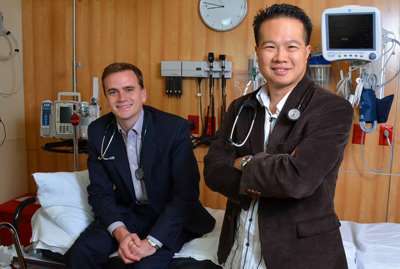The Obamacare Revolt: Physicians Fight Back Against the Bureaucratization of Health Care
Will it make a difference?
Dr. Ryan Neuhofel, 31, offers a rare glimpse at what it would be like to go to the doctor without massive government interference in health care. Dr. Neuhofel, based in the college town of Lawrence, Kansas, charges for his services according to an online price list that's as straightforward as a restaurant menu. A drained abscess runs $30, a pap smear, $40, a 30-minute house call, $100. Strep cultures, glucose tolerance tests, and pregnancy tests are on the house. Neuhofel doesn't accept insurance. He even barters on occasion with cash-strapped locals. One patient pays with fresh eggs and another with homemade cheese and goat's milk.

"Direct primary care," which is the industry term for Neuhofel's business model, does away with the bureaucratic hassle of insurance, which translates into much lower prices. "What people don't realize is that most doctors employ an army of people for coding, billing, and gathering payment," says Neuhofel. "That means you have to charge $200 to remove an ingrown toenail." Neuhofel charges $50.
He consults with his patients over email and Skype in exchange for a monthly membership fee of $20-30. "I realized people would come in for visits with the simplest questions and I'd wonder, why can't they just email me?" says Neuhofel. Traditional doctors have no way to get paid when they consult with patients over the phone or by email because insurance companies only pay for office visits.
Why did he choose this course? Neuhofel's answer: "I didn't want to waste my career being frustrated."
This model is growing in popularity. Leading practitioners of direct primary care include Seattle, Washington-based Qliance, which has raised venture capital funding from Jeff Bezos, Michael Dell, and comedian (and Reason Foundation Trustee) Drew Carey; MedLion, which is about to expand its business to five states; and AMG Medical Group, which operates several offices in New York City. Popular health care blogger Dr. Rob Lamberts has written at length about his decision to dump his traditional practice in favor of this model.
"Since I started my practice, I seem to hear about another doctor or clinic doing direct primary care every other week." says Neuhofel.
Direct primary care is part of a larger trend of physician-entrepreneurs all across the country fighting to bring transparent prices and market forces back to health care. This is happening just as the federal government is poised to interfere with the health care market in many new and profoundly destructive ways.
Obamacare, which takes full effect in 2014, will drive up costs and erode quality—and Americans will increasingly seek out alternatives. That could bring hordes of new business to practitioners like Neuhofel, potentially offering a countervailing force to Obamacare. (One example, the Surgery Center of Oklahoma's Dr. Keith Smith, profiled for Reason TV in September, is doing big business offering cash pricing for outpatient surgery at prices about 80 percent less than at traditional hospitals.)
Health "insurance" is more than just insurance; it's also "a payment plan for routine expenses," as University of Chicago business school economist John Cochrane puts it in a superb recent paper. The late free-market economist Milton Friedman pointed out that we insure our houses against fire and our cars against major damage, but we don't also insure ourselves against cutting the lawn and buying gas. That's the main reason innovation almost never makes health care cheaper. Most patients never see the bill for an ingrown toenail removal or a glucose tolerance test, so doctors have little incentive to seek ways to offer their services for less. For simple consultations, why bother with Skype when insurance will pay full price for an office visit.
Insurance plans that cover everything, a situation that came about largely because of a quirk in our tax code, have also led to the "bureaucratization of medical care," Friedman wrote in a 2001 essay, in which "the caregiver has become, in effect, an employee of the insurance company or…the government."
Dr. Lisa Davidson had 8 years of frustration while running a successful traditional practice in Denver, Colorado. She had 6,000 patients when she decided to stop taking insurance and adopt the same business model as Neuhofel. Her patient list has dropped to about 2,000. She used to spend about 15 minutes with each patient and now it's more like 45 minutes. "We're on track to make more money and take better care of our patients," says Davidson. "It's a win-win all around."
Before adopting direct primary care, Davidson was unhappy working at the practice she had built because the insurance system imposed a way of doing business that resembled an assembly line. "It's true that in 2014, many more people will have insurance, so there will be a profound need for primary care doctors," says Davidson. "You might say I've done a disservice by dramatically cutting the size of my practice. However, if we make it desirable again to be a primary care physician more people will want to do it."
Under Obamacare, more and more doctors are becoming employees of large hospitals, where there will be more control over how they practice medicine. Hoover Institution Senior Fellow Dr. Scott Atlas fears this will cause a brain drain in medicine. "Really smart people want autonomy, and when you take that away it's naive to think you're going to get really bright people becoming doctors," says Atlas. "The best doctors could excel at any profession, so why go into medicine if they won't have the opportunity to be their best?"
When she was operating a traditional practice, Davidson witnessed firsthand how our "payment plans for routine expenses" drive up prices and block innovation. She recalls that one insurance company paid $118 for a routine PSA test. Now that her patients pay the bill directly the cost is $18. Insurance used to pay $128 for a bag of IV fluid. Now Davidson doesn't bother passing on the cost of IV bags because they run $1.50 each.
Dr. Eric Bricker is the medical director at Compass, a Dallas-based company that helps individuals with high-deductible insurance plans. In a previous job, Bricker was a finance consultant for hospitals, giving him firsthand knowledge of how health insurance drives up prices. "When insurance companies and hospitals negotiate," says Bricker, "it's an exercise in horse trading." For example, an insurance company might let a hospital get away with charging $2,000 for an MRI, says Bricker. In exchange, the hospital agrees to charge the bargain price of $2,000 to deliver a baby. "You do that mixing and matching," says Bricker, "and at the end of the day it works out about even."
According to Bricker, this horse-trading method provides an opportunity for hospitals to earn windfall profits: If the hospital gets $2,000 for MRIs, it will start encouraging patients to get more MRIs.
Given how prices are set, it's no mystery why in health care high costs often correlate with low quality. Bricker cites one facility in Dallas, where a 3-tesla MRI (the more teslas, the higher the resolution) can be had for $860, while a nearby facility offers a 1.5-tesla MRI for $2,500. The latter facility stays in business only because many of its customers don't know the difference. They pay the same $20 co-pay wherever they go for an MRI.
So Bricker co-founded Compass, which works with about 1,200 firms to guide their employees to those doctors and testing facilities that offer both high quality and low prices. These employees have an incentive to seek out value because they're responsible for paying a large portion of their own routine medical costs before their insurance coverage kicks in.
High-threshold plans are exploding in popularity, which is a promising trend. According to a 2012 report by the Kaiser Family Foundation, about 31 percent of firms now offer health plans in which patients pay most routine costs out of pocket, like a Health Savings Account (HSA) or Health Reimbursement Arrangement (HRA), and 19 percent of covered workers have one of these plans. High-deductible plans go a long way towards unbundling our "payment plans for routine expenses" from the catastrophic coverage that should be the sole function of health insurance.
"These plans offer hope," says Scott Atlas, "because they drive patients to care about what things cost. High deductible policies also eliminate much of the administrative cost of insurance because there's no need to file claims for routine charges."
Obamacare imposes new mandates on high-deductible plans, but it doesn't outlaw them. "The most devastating thing Obamacare could have done is to say it's illegal to have a deductible of more than $200," says Bricker. "So within the existing confines we can still have a successful business and help people."
Americans with high-deductible policies still have the misfortune of shopping for services in a health care market dominated by traditional health insurance. Since insurance companies and the government still pay the vast majority of medical bills, it's nearly impossible to find doctors who offer competitive and transparent prices.
A Houston-based start up called Snap Health is trying to remedy that by signing up doctors to list their prices on its website. Currently, there are 290 tests and about 100 doctors to choose from. You can buy an EKG (about $35), have a kidney stone analyzed ($250), or get a heart check up (about $400). Patients choose the procedure they want, pay online with a credit card, and then show up for their appointments. Snap Health's CEO and Co-founder Dr. David Wong says the biggest obstacle to building up a menu of offerings is that doctors accustomed to getting paid by insurance companies have no idea how to price their services for direct-paying clients.

Wong says he launched his business partly on the belief that Obamacare will drive up health care costs, causing more and more companies and individuals to drop out and start paying their own health care bills. Neuhofel agrees that Obamacare could be good for business. "I expect some real unintended consequences after Obamacare is implemented. There could be more uninsured people."
Lisa Davidson plans to enter the state-based exchanges that Obamacare will put in place. She cites a provision in the Affordable Care Act that explicitly allows direct primary care practitioners to marry their services with a catastrophic plan and enter the exchanges, although the details of what will be permitted under the law haven't been hammered out yet.
Eric Bricker also sees opportunity to work within the Affordable Care Act. "Compass is trying to make lemonade out of lemons," he says. "I think you can incrementally make improvements within Obamacare, and the situation will change over time."
The efforts of these doctors and others will undoubtedly help constrain exploding health care costs and improve care. But it's hard to fathom how within the legal constraints of Obamacare we'll see the sort of innovations that could solve the very problems that, ironically, were used to justify Obamacare's passage. As economist John Cochrane puts it, without government meddling, health insurance would be "individual, portable, life?long, guaranteed?renewable, transferrable, [and] competitive." And going to the doctor would be as simple and straightforward as eating out. What needs to be done to get there is painfully obvious.
